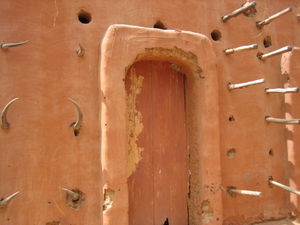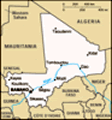Advertisement
Published: June 25th 2007

 Horny walls
Horny walls
A traditional Malian mud building, replete with goats horns
Tom Griffith According to the United Nations, Mali is the third poorest country in the world. Now, I'm not sure how they come up with these rankings (it tells you
here), but as someone from the third
richest country, it sure feels poor to me. So how do Malians manage to be so open and friendly? I don't know. And why did the guy in the shop I just popped into, offer me some of his lunch? Again, I don't know. But Malians do have a reputation for being nice folks, and so far I haven't been disappointed - apart, perhaps, from the super-pushy touts and hassle-mongers of Segou. But more on them later.
Mali's poverty stems from a variety of complex causes, but basically it comes down to two: colonialism and the environment. Whereas the French did a fair bit to develop Senegal during their rule over the place, Mali was always a backwater - too dry and distant to do much with. When independence came in 1960, the Malians did the best they had with their scarce resources, but the inevitable run of coups and chaos followed, and the place settled into a cycle of poverty and mismanagement. The

 Bamako mural
Bamako mural
A colourful mural outside Mali's Assemblee Nationalfact that Mali is a vast expanse of scrub, desert, and dry soil, with a lack of access to good water, and a chronic shortage of resources, doesn't help things.
We arrived at the Malian border after a fairly hellish journey across Senegal, through real Sahel country - lots of dry scrubland and red dust, dotted with the weird,wonderful, contorted shapes of large baobabs. If the sun hadn't been so harsh, and the transport so awful, it might have been quite a beautiful part of the trip. But no, it was a test of our stamina more than anything.
At the border, we were relieved to find that the formalities were pretty relaxed, although we did have to search for the Malian police post to have our passports stamped. Eventually, we found it hidden behind a bunch of farmhouses, and one of the cops left a game of cards to sort us out. The sight of a young guy lying on the floor of the office, handcuffed to a bench a few metres away from us, was somewhat disconcerting.
Everything seemed to slow down once we hit Mali. The relentless 45-degree heat probably had something to do

 Niger pirogue
Niger pirogue
A boat moored on the bank of the Niger River, in Segouwith that. After immigration, we found the bush taxis to Kayes, the first sizeable town across the border. These were exactly the same Peugeot taxis they use in Senegal, but, being significantly poorer than the nation to its west, Mali manages to squeeze not seven, but eight, passengers into one of these converted station-wagons. The road to Kayes was surprisingly good - in marked contrast to the state of our hotel room, which bore a remarkable resemblance to a prison cell, from its poky dimensions to the spatters of what looked like urine and blood on all four walls. The heat was more than stifling, and had some strange effects on both us and our possessions. The insides of my sandals were too hot for my feet. My shampoo felt like it had been in the microwave. A loaf of bread we bought felt like it had just come out of the oven- and still felt like that four hours later. A welcome rainstorm lowered the temperatures a tad, as did our trusty heat-scarves. If you don't have one, then contact Suze's grandma and get her to buy you one, quicksmart. Thanks again, Mrs Juster!
We left Kayes as

 Bamako street
Bamako street
Me poisng with my water bottle in a busy Bamako streetsoon as possible, the following morning at 4.30 in fact, when our taxi driver banged on the door to wake us, to be greeted by the hideous sight of me in my boxer shorts and purple heatscarf. The road to Bamako used to be pretty dire, but has recently been tarmacced, so the 600-km journey only took 9 hours or so.
Bamako is your archetypal African capital city - dirty and tatty, steamy yet dusty, full of corrugated iron and smoke-belching mopeds and NGO four-wheel drives and women carting massive baskets around on their heads. The place isn't loaded with sights, or stunning architecture, or an amazin location - it is just a raggedy, poor city sitting on the banks of the grubby Niger River. Yet is has quite a charm of its own, and feels a lot safer than Dakar. The people are great, and there are some incredible markets to get lost in. The largest is the aptly named Grand Marche, where you can buy anything from multicoloured African textiles to freshly smithied silver jewellery. The highlight has to be the small selection of fetish stalls, which provide such essentials as dried baboon heads, dessicated chameleons, and

 Our local restaurant
Our local restaurant
The poky little restaurant directly opposite our nun-run hotel, and the cigarette stall next to it, Bamakogazelle skins; hardly great for th preservation of West African wildlife, but a reminder of the existence of animist religion and medicine in what is mainly a Muslim country.
We stayed right in the centre of Bamako, in the Mission Catholique, a bunch of rooms rented out by some French nuns. The place was a brilliant respite fromthe dirt and clamour outside - spotlessly clean, with a fridge, where we could freeze our mineral water. Such minor luxuries really mean a lot in this part of the world. In fact, our current room, in the city of Segou, is perhaps our best yet, for the simple reason that it has CNN - in English, not French, oh thank you, sweet God - and - wait for it - a swimming pool. There is no better way to escape that Malian heat, let me tell you.
Yep, after a few days in Bamako sorting our Burkina Faso visas, we moved on to the sleepy riverside settlement of Segou. The Lonely Planet raves about the tranquility of the spot, but forgets to mention the 50 guys who hound you constantly trying to sell motorbike trips, boat trips, wooden masks, guide

 Place de la Nation
Place de la Nation
The monument marking Mali's achievement of independence in 1960, in Bamakoservices, keyrings, shoeshines, whatever. If you can ignore them - and their guilt trips, and accusations of racism, and aggressive salesmanship - then Segou is a lovely town, with tree-lined boulevards and a great location on the Niger. But they are hard work to ignore, and yesterday they were so full-on that they forced us back to the hotel room, nearly defeated. They geninely make you feel like a complete bastard for not buying stuff from them, and remind you of how privileged you are in that white skin. It takes a good, hard reality check to remember that they are poor and desperate, and are simply finding your weak spot in order to make a sale.
Partly for this reason, my thoughts on Mali right now are quite mixed. The people are strong, welcoming and have a great sense of humour. The land is starkly beautiful. Yet the grinding poverty and desperation are incredibly hard to wrap your head around. Mali is what I imagined Africa would be - a complex place that arouses more than just your positive emotions.
Advertisement
Tot: 0.09s; Tpl: 0.014s; cc: 13; qc: 30; dbt: 0.046s; 1; m:domysql w:travelblog (10.17.0.13); sld: 1;
; mem: 1.1mb










Nell
non-member comment
The girl from Ipanema
how are you able to write such complex critique in such heat! it makes me feel so lazy!! actually..... the fact that i´m going to be lying on a beach in rio de janeiro tomorrow kind of makes me feel lazy too!! although in a good way!